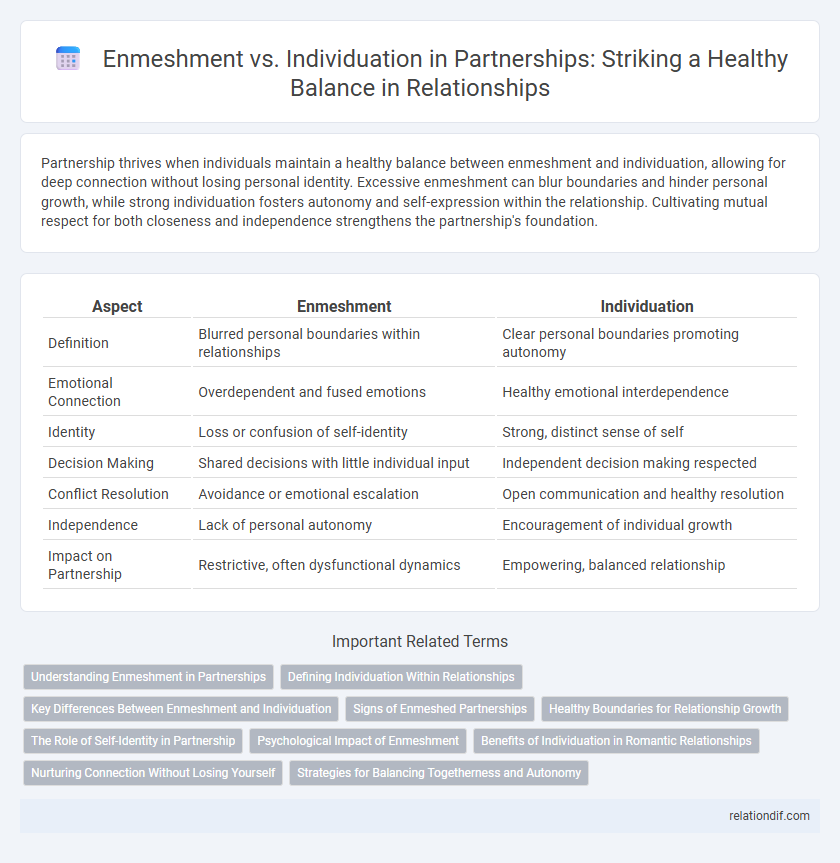Partnership thrives when individuals maintain a healthy balance between enmeshment and individuation, allowing for deep connection without losing personal identity. Excessive enmeshment can blur boundaries and hinder personal growth, while strong individuation fosters autonomy and self-expression within the relationship. Cultivating mutual respect for both closeness and independence strengthens the partnership's foundation.
Table of Comparison
| Aspect | Enmeshment | Individuation |
|---|---|---|
| Definition | Blurred personal boundaries within relationships | Clear personal boundaries promoting autonomy |
| Emotional Connection | Overdependent and fused emotions | Healthy emotional interdependence |
| Identity | Loss or confusion of self-identity | Strong, distinct sense of self |
| Decision Making | Shared decisions with little individual input | Independent decision making respected |
| Conflict Resolution | Avoidance or emotional escalation | Open communication and healthy resolution |
| Independence | Lack of personal autonomy | Encouragement of individual growth |
| Impact on Partnership | Restrictive, often dysfunctional dynamics | Empowering, balanced relationship |
Understanding Enmeshment in Partnerships
Enmeshment in partnerships occurs when boundaries between individuals become blurred, leading to a loss of personal autonomy and identity. This dynamic often results in excessive emotional dependence, making it difficult for partners to maintain healthy individuality. Recognizing and addressing enmeshment is crucial for fostering individuation and promoting balanced, supportive relationships.
Defining Individuation Within Relationships
Individuation within relationships involves maintaining a clear sense of self while forming meaningful connections, enabling partners to support each other's growth without losing personal identity. This balance prevents enmeshment, where boundaries blur and autonomy diminishes, leading to dependence and emotional entanglement. Healthy individuation fosters emotional resilience and mutual respect, crucial for sustainable partnership dynamics.
Key Differences Between Enmeshment and Individuation
Enmeshment in a partnership involves blurred boundaries where personal identities merge, leading to dependency and loss of self, while individuation emphasizes maintaining distinct identities and personal autonomy within the relationship. Key differences highlight emotional fusion versus healthy separateness, where enmeshed partners struggle with codependency and individuation fosters self-awareness and mutual respect. Understanding these contrasts promotes balanced connections that support both intimacy and individual growth.
Signs of Enmeshed Partnerships
Signs of enmeshed partnerships include a lack of personal boundaries, where partners overly depend on each other for emotional support and decision-making. Individuals may struggle to maintain separate identities, leading to blurred roles and a loss of autonomy. Persistent involvement in each other's thoughts and feelings often results in codependency and difficulty establishing healthy independence within the relationship.
Healthy Boundaries for Relationship Growth
Healthy boundaries in partnerships foster a balance between enmeshment and individuation, promoting mutual respect and personal autonomy. Establishing clear emotional and physical limits enhances trust, communication, and emotional intimacy, preventing codependency and loss of self. Prioritizing boundary-setting empowers both partners to grow individually while nurturing a resilient, connected relationship.
The Role of Self-Identity in Partnership
Self-identity plays a crucial role in partnerships by balancing enmeshment and individuation to maintain healthy relationship dynamics. Partners with a strong sense of self can establish boundaries that prevent emotional enmeshment while fostering individuality. This balance enhances mutual respect and supports personal growth within the partnership.
Psychological Impact of Enmeshment
Enmeshment in partnerships often leads to blurred personal boundaries, causing individuals to lose their sense of identity and autonomy. This psychological entanglement can result in heightened anxiety, dependency, and impaired decision-making abilities. Establishing clear individuation within relationships promotes emotional resilience and healthier communication dynamics.
Benefits of Individuation in Romantic Relationships
Individuation in romantic relationships fosters personal growth and emotional resilience, enhancing overall relationship satisfaction. Partners who maintain a strong sense of self are better equipped to communicate their needs clearly and support each other's individuality. This balance between togetherness and autonomy strengthens trust and deepens emotional intimacy, leading to a healthier, more sustainable partnership.
Nurturing Connection Without Losing Yourself
Maintaining a healthy partnership requires balancing enmeshment and individuation by nurturing emotional connection while honoring personal boundaries. Establishing clear communication and mutual respect fosters intimacy without sacrificing individual identity. Prioritizing self-awareness and autonomy helps partners grow together, creating a resilient and fulfilling relationship.
Strategies for Balancing Togetherness and Autonomy
Effective strategies for balancing togetherness and autonomy in partnerships include setting clear personal boundaries and fostering open communication to respect individual needs. Encouraging shared activities alongside independent pursuits enhances mutual growth without compromising self-identity. Consistently revisiting and negotiating relationship expectations ensures a dynamic equilibrium between enmeshment and individuation.
enmeshment vs individuation Infographic

 relationdif.com
relationdif.com